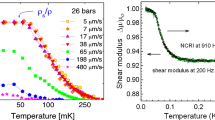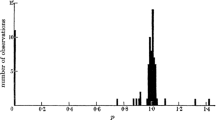Abstract
This article comprises the first part of a study concerning the effect that a flow of gaseous4He has on the concentration distribution of3He atoms in the presence of a super fluid film. We present a simple model in which hydrodynamic effects in the gas phase (diffusion and viscosity), and local thermodynamic equilibrium with a superfluid film are considered. Results are derived and discussed for the simple case in which a heat flow is sustained along a cylindrical tube lined with a helium film. This heat flux drives a superfluid flow in the film, and a corresponding counterflow of4He in the vapour. The pressure, temperature,3He concentration, and film thickness profiles along the tube are computed. Over a wide range of conditions, a dramatic reduction of the3He concentration, a large temperature increase, and a spectacular film thinning towards hotter regions are predicted to result from a heat flow. The results of a series of experiments supporting this model will be presented in a forthcoming article.
Similar content being viewed by others
References
A. Matthey, Ph.D. Thesis, Amsterdam (1987).
I. F. Silvera and J. T. M. Walraven,Phys. Rev. Lett. 44, 164 (1980).
M. Mertig, A. V. Levkovitch, V. G. Luppov, and Y. K. Pilipenko,Rev. Sci. Instrum. 63, 2220 (1992).
Various workers have mentioned the possibility that a flowing superfluid film will influence the vapour composition, in particular when measuring the liquid vapour equilibrium phase diagram of helium mixtures. See for example: J. G. Daunt, R. E. Probst, H. L. Johnston, L. T. Aldrich, and A. O. Nier,Phys. Rev. 72, 502 (1947); H, A. Fairbank, C. T. Lane, L. T. Aldrich, and A. O. Nier,Phys. Rev. 73, 729 (1948); D. H. N. Wansink, K. W. Taconis, and F. A. Staas,Physica 22, 449 (1956).
G. Tastevin,J. Low Temp. Phys. 89, 317 (1992).
M. Cornut, P. J. Nacher, and G. Vermeulen,J. Low Temp. Phys. 89, 527 (1992).
M. E. Hayden, M. Cornut, and P. J. Nacher,Physica B194–196, 677 (1994).
J. O. Hirschfelder, C. F. Curtiss, and R. B. Bird, Molecular Theory of Gases and Liquids, Chapter 7, M. Goeppert Mayer ed., John Wiley & Sons (1964).
Ibid., chapter 8.
V. M. Kontorovitch,Zh. Eksp. Teor. Fiz. 30, 805 (1956) [Translated Sov. Phys. JETP3, 770 (1956)].
D. L. Godstein and P. G. Saffman,J. Low Temp. Phys. 18, 435 (1975).
S. Franchetti,Nuovo Cimenta 10, 622 (1958).
D. T. Eckholm and R. B. Hallock,J. Low Temp. Phys. 42, 339 (1981).
R. de Bruyn Ouboter, J. J. M. Beenakker, and K. W. Taconis,Physica 25, 1162 (1959).
J. G. Daunt and K. Mendelssohn,Propc. Roy. Soc. London A 170, 423 (1939).
P. C. Hendry and P. V. E. McClintock,Cryogenics 27, 131 (1987).
S. Dushman, “Scientific Foundations of Vacuum Technique,” Chap. 2, Sec. 3, John Wiley & Sons (1949).
M. Knudsen,Ann. Physik 28, 75 (1909).
E. W. Becker, R. Misenta, and F. Schmeissner,Phys. Rev. 93, 244 (1954).
J. De Boer,Prog. Low Temp. Phys. Vol. I, Chap. XVIII, p. 381, C. J. Gorter ed., North Holland Publishing Company (1955).
P. J. Nacher, to be published inJ. Chem. Phys. (1994).
M. Himbert, J. Dupont-Roc, and C. Lhuillier,Phys. Rev. A 39, 6170 (1989).
P. J. Bendt,Phys. Rev. 110, 85 (1958).
M. Himbert, J. Dupont-Roc, M. Leduc, and P. J. Nacher,Jap. Journal App. Phys. 26, supp. 26–3, 211 (1987).
R. L. Rusby and M. Durieux,Cryogenics 24, 363 (1984).
S. G. Sydoriak and T. R. Roberts,Phys. Rev. 118, 901 (1960).
A. K. Sreedhar and J. G. Daunt,Phys. Rev. 117, 891 (1960).
E. M. Lifshitz and L. P. Pitaevskii, “Statistical Physics” (part 1), Sec. 95, Pergamon Press (1980).
R. A. Buckingham and R. A. Scriven,Proc. Phys. Soc. [Lond.]A 65, 376 (1952).
J. J. Hurly, W. L. Taylor, and F. R. Meeks,J. Chem. Phys. 96, 3775 (1992).
E. S. Sabisky and C. H. Anderson,Phys. Rev. Lett. 30, 1122 (1973).
Author information
Authors and Affiliations
Additional information
Unité de recherche de l'Ecole Normale Supérieure et de l'Université Pierre et Marie Curie, associée au CNRS (URA 18).
Rights and permissions
About this article
Cite this article
Nacher, P.J., Cornut, M. & Hayden, M.E. Compression of3He by refluxing4He: A model for computing HEVAC effects in3He-4He mixtures. J Low Temp Phys 97, 417–443 (1994). https://doi.org/10.1007/BF00754302
Received:
Revised:
Issue Date:
DOI: https://doi.org/10.1007/BF00754302




